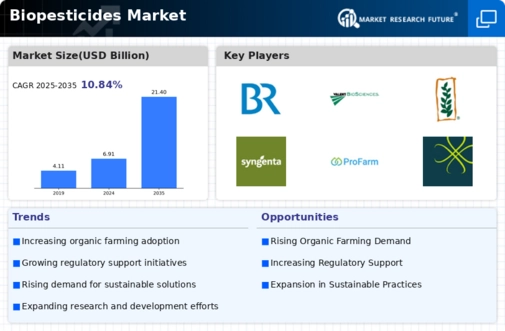Top Industry Leaders in the Biopesticides Market
 The Thriving Biopesticide Market: A Competitive Landscape in Bloom
The Thriving Biopesticide Market: A Competitive Landscape in Bloom
The biopesticides market, a beacon of sustainability in the agricultural realm, is experiencing a meteoric rise. Fueled by growing consumer awareness, stringent regulations on synthetic pesticides, and the burgeoning organic farming sector, this market is projected to reach a staggering USD 13.2 billion by 2030, boasting a CAGR of 13.3% .But amidst this verdant growth, a fiercely competitive landscape emerges, where established players jostle with nimble newcomers for market share.
Key Players and their Strategies:
- DuPont (U.S.)
- Bayer Crop Science AG (Germany)
- Monsanto Company (U.S.)
- BASF SE (Germany)
- Novozymes Biologicals (Denmark)
- Syngenta (Switzerland)
- Certis USA LLC (U.S.)
Strategies for Market Share Analysis:
The battle for market share is a dynamic one, fueled by diverse factors. Product portfolios play a crucial role, with companies offering a wider range of biopesticides for various crops and pests gaining an edge. Geographical presence and distribution channels are equally important, with strong regional networks and partnerships with local distributors proving advantageous. Additionally, R&D prowess and the development of novel biocontrol agents, especially those targeting specific pest problems, can catapult companies ahead.
New and Emerging Players:
While established names dominate the market, the biopesticides landscape is constantly evolving, with new players sprouting like seeds in fertile soil. Companies like BioWorks Inc. and Novozymes are making waves with their innovative enzyme-based bioinsecticides, while others like Indigo Agriculture are focusing on microbial seed treatments, offering a holistic approach to pest control. These new entrants, with their agility and focus on niche markets, are challenging the status quo and keeping established players on their toes.
Industry News and Investment Trends:
The biopesticides market is buzzing with exciting developments. Recent acquisitions like Valent Biosciences' purchase of Bio-Control Alliance and BASF's investment in ICL highlight the growing confidence in the sector. Additionally, government initiatives like the US EPA's "Reduced Risk Pesticides" program are providing a fertile ground for innovation.
Competitive Scenario: A Blossoming Battleground
The biopesticides market is a dynamic ecosystem where established players, nimble newcomers, and disruptive technologies compete for dominance. While established players leverage their resources and brand recognition, newcomers bring agility and innovative solutions. The battle for market share hinges on a delicate balance of product portfolios, regional presence, R&D prowess, and strategic alliances.
The future of the biopesticides market appears vibrant, with continuous innovation and an ever-evolving regulatory landscape shaping the competitive landscape. As consumer consciousness and environmental concerns gain momentum, the biopesticides market is poised to bloom further, offering sustainable solutions for a healthier planet.
Company Update :
At the forefront stand established giants like Corteva Agriscience, wielding their vast resources and extensive distribution networks. Corteva's strategy revolves around a diverse portfolio of biofungicides and bioinsecticides, along with strategic acquisitions like the recent Provivi deal, solidifying their position as a leader. Similarly, Marrone Bio Innovations leverages its focus on novel bio-based technologies like microbial insecticides and RNAi-based solutions to carve a niche.
European players like Andermatt Group AG and Koppert Biological Systems Inc. capitalize on their expertise in microbial and insect-based biocontrol agents, particularly thriving in the European market with its stringent regulations. Asia, on the other hand, sees the rise of regional players like Gujarat State Fertilizers & Chemicals Ltd., leveraging their cost-effective production capabilities to cater to the burgeoning demand in the Indian subcontinent.

